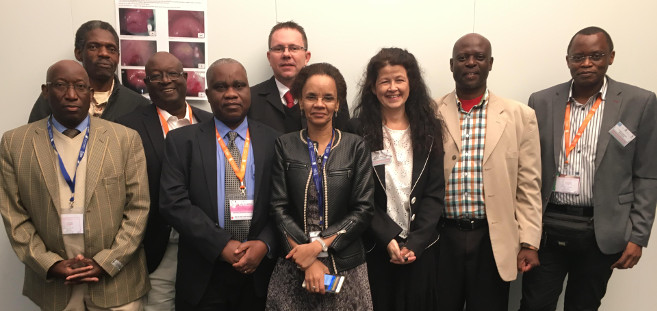 Bilharzia experts at the launch of the Pocket Atlas.
Bilharzia experts at the launch of the Pocket Atlas.New Pocket Atlas to Help Combat Female Bilharzia
Gynaecologists and researchers at UKZN’s College of Health Sciences, in partnership with colleagues from the World Health Organization (WHO), have launched a booklet to assist doctors diagnose and manage female genital tract bilharzia.
Some of the world’s leading gynaecologists and researchers gathered at the South African Congress for Gynaecologists and Obstetricians in the North West for the launch of the WHO Pocket Atlas for Female Genital Schistosomiasis (FGS) that will assist health professionals recognise female bilharzia.
‘Doctors know bilharzia, but very few know the damage it can do to female genitals,’ said Dr Francis Hyera of University of Limpopo.
‘The early stages are difficult to see with the naked eye, especially before proper training. During gynaecological examinations on women with bilharzia, it is often misconceived as cancer or an STI. Even among health workers able to do the microscopic examination of the genitalia (colposcopy), few recognise the disease.’
The microscopic bilharzia parasites live in fresh water and can penetrate the skin upon contact. No pain is felt and the patients are unaware of the invasion. Swimming or doing laundry in infested rivers, lakes and lagoons poses a high risk. The parasites can stay in the body for over 30 years and can cause great damage. Research shows that bilharzia affects both men and women and people of all ages. Children are particularly susceptible.
‘It is unacceptable that people are suffering from this disease and that children are still contracting it,’ said Dr Eyrun Kjetland of UKZN.
‘Brazil and Egypt have successfully treated their populations for bilharzia and hopefully South Africa will do the same. The parasite can cause a gynaecological disease called female bilharzia which is painful, causing chronic bleeding, and infertility. Studies have shown that up to two million women in South Africa might be affected. Unfortunately, very few receive treatment with insufficient knowledge of the disease and lack of health services the main reasons for this low treatment coverage.
‘Most of the 290 000 doctors and nurses in South Africa rely on blood in urine as a symptom for urinary bilharzias and only handful are aware of genital bilharzia and its effects,’ said Dr Motshedisi Sebitloane, Chief Specialist at UKZN’s Department of Gynaecology. ‘If the genitalia are affected, this can result in unscheduled bleeding, chronic pelvic pain and infertility – even if nothing is found in the urine. By increasing knowledge with the World Health Organization booklet and teaching every health professional in this country what the disease looks like, we could eliminate this public health problem.’
Head of Department at the South Africa Department for Communicable Disease Control, Mr Tsakani Furumele, said: ‘We are fighting against time to spread information about this disease all over sub-Saharan Africa where it is prevalent. Children living in endemic areas should be targeted with early, regular “preventive treatments” to prevent life-long damage to their reproductive organs. The longer we delay raising awareness about the disease, the more infected people remain undiagnosed and vulnerable to sexually transmitted infections, including HIV. Our aim is that you will find this pocket booklet in every clinician’s office within two years.’
Nombuso Dlamini



